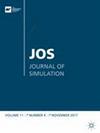Machine learning integrated patient flow simulation: why and how?
IF 1.3
4区 工程技术
Q4 COMPUTER SCIENCE, INTERDISCIPLINARY APPLICATIONS
引用次数: 1
Abstract
ABSTRACT Stochastic distribution methods were used to construct patient flow simulation sub-models such as patient inflow, length of stay (LoS), cost of treatment (CoT) and clinical pathways (CPs). However, the patient inflow rate demonstrates seasonality, trend, and variation due to natural and human-made factors. LoS, CoT and CPs are determined by social-demographics factors, clinical and laboratory test results, resource availability and healthcare structure. For this reason, patient flow simulation models developed using stochastic methods have limitations including uncertainty, not recognising patient heterogeneity, and not representing personalised and value-based healthcare. This, in turn, results in a low acceptance level and implementation of solutions suggested by patient flow simulation models. On the other hand, machine learning becomes effective in predicting patient inflow, LoS, CoT, and CPs. This paper, therefore, describes why coupling machine learning with patient flow simulation is important, proposes a conceptual architecture for machine learning integrated patient flow simulation and demonstrates its implementation with examples.机器学习集成患者流程模拟:为什么和如何?
采用随机分布方法构建患者流模拟子模型,包括患者流入、住院时间(LoS)、治疗费用(CoT)和临床路径(CPs)。然而,由于自然和人为因素的影响,患者流入率具有季节性、趋势和变化性。LoS、CoT和cp由社会人口因素、临床和实验室测试结果、资源可用性和卫生保健结构决定。因此,使用随机方法开发的患者流模拟模型具有局限性,包括不确定性、不能识别患者异质性、不能代表个性化和基于价值的医疗保健。这反过来又导致患者流模拟模型建议的解决方案的接受程度和实施程度较低。另一方面,机器学习在预测患者流入、LoS、CoT和cp方面变得有效。因此,本文描述了机器学习与患者流程模拟耦合的重要性,提出了机器学习集成患者流程模拟的概念架构,并通过示例演示了其实现。
本文章由计算机程序翻译,如有差异,请以英文原文为准。
求助全文
约1分钟内获得全文
求助全文
来源期刊

Journal of Simulation
COMPUTER SCIENCE, INTERDISCIPLINARY APPLICATIONS-OPERATIONS RESEARCH & MANAGEMENT SCIENCE
CiteScore
5.70
自引率
16.00%
发文量
42
期刊介绍:
Journal of Simulation (JOS) aims to publish both articles and technical notes from researchers and practitioners active in the field of simulation. In JOS, the field of simulation includes the techniques, tools, methods and technologies of the application and the use of discrete-event simulation, agent-based modelling and system dynamics.
 求助内容:
求助内容: 应助结果提醒方式:
应助结果提醒方式:


